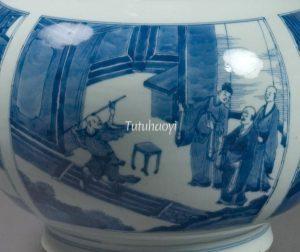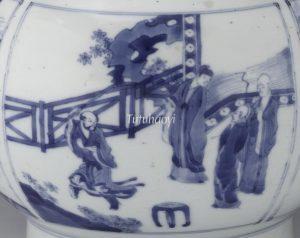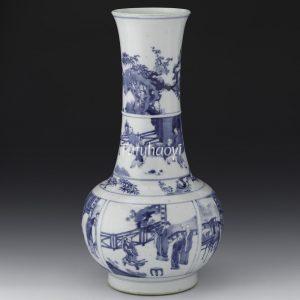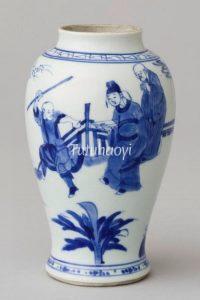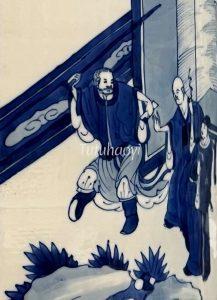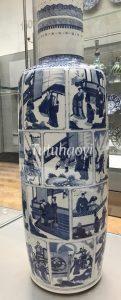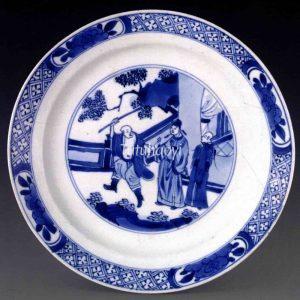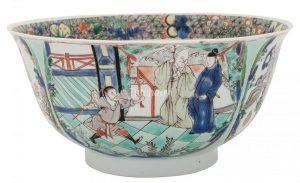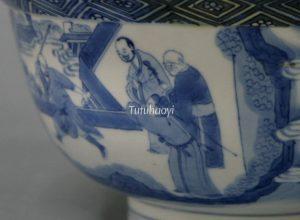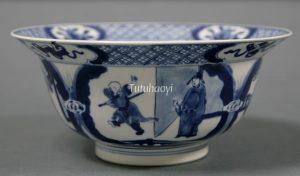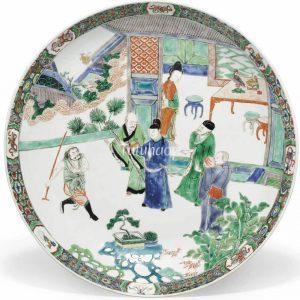Huiming delivering a letter for help
惠明寄书 (溃围请救)
© Tutuhaoyi.com owns the copyright of the description content for the images attached. Quoting all or part of the description content on this page is permitted ONLY IF ‘Tutuhaoyi.com’ is clearly acknowledged anywhere your quote is produced unless stated otherwise. (本页描述内容版权归Tutuhaoyi.com所有,转发或引用需注明 “Tutuhaoyi.com”, 侵权必究, 已注开源信息的条目除外。)
This is Scene Two of Act Two of the Chinese classic popular drama Romance of the Western Chamber (西厢记 Xixiang Ji), written by the Yuan playwright Wang Shifu (1250–1336).
Sun Feihu 孙飞虎, a local bandit, was attracted to Miss Cui Yingying (崔莺莺)’s beauty and wanted to abduct her from the Buddhist monastery where her temporary residence was with her family. Zhang Gong 张珙 (styled Junrui 君瑞, nickname Scholar Zhang 张生), who fell in love with Yingying, was also stuck in the temple. As the monastery was surrounded by Sun’s army, Yingying’s mother promised that whoever defeated the Sun’s army could marry her daughter.
Scholar Zhang came up with an idea of asking help from his childhood friend Du Que 杜确, who was known as ‘General White Horse (白马将军)’. He was leading a troop of a hundred thousand warriors and stationed at Puguan Pass 蒲关, about forty to fifty miles away. Scholar Zhang was confident that if his letter for help was sent to General White Horse, the general would be able to come to the rescue and defeat the bandit. However, Zhang Gong himself, as a weak scholar, was unable to break through the heavy siege of the army to deliver the letter. Who would be the most suitable person then? The head abbot, Fa Ben 法本, thought of a monk named Huiming 惠明 who was known for indulging in food and alcohol, and neglecting Buddhist practices. Sure enough, with the right words, Huiming was excited and keen to take up the task. On his way out, he promised good news upon his return.
story scene description by Rachel Ma
Other episodes in the Romance of the Western Chamber:
Scholar Zhang embarking on his journey to sit for civil-service examinations 张生赶考
Scholar Zhang renting a room in the monastery 僧房假寓 (禅关假馆)
Scholar Zhang and Cui Yingying exchanging verses in the garden 唱和东墙 (墙角联吟)
Scholar Zhang getting drunk due to Madame Cui’s broken promise 张生醉酒 (崔母悔婚)
Fig 1: porcelain dish with overglaze enamelled decoration, Kangxi period (1662–1722), Qing dynasty, courtesy of The Guimet Museum, Paris, photograph by Mr Raid Kneife
Fig 2-3: porcelain vase with underglaze blue decoration, Kangxi period (1662–1722), Qing dynasty, courtesy of the Metropolitan Museum of Art, New York
Fig 4-5: porcelain vase with underglaze blue decoration, Kangxi period (1662–1722), Qing dynasty, courtesy of Shanghai Museum, China
Fig 6: porcelain vase with underglaze blue decoration, Kangxi period (1662–1722), Qing dynasty, courtesy of The Dresden Porcelain Collection, State Art Collections of Dresden, Germany, Inventory number: PO 7115
Fig 7: famille verte bowl, Kangxi period (1662–1722), Qing dynasty, courtesy of The Royal Dresden Porcelain Collection, Dresden State Art Collections, Germany
Fig 8-9: rouleau vase with underglaze blue decoration, Kangxi period (1662–1722), Qing dynasty, courtesy of the Victoria & Albert Museum, London, photograph by Mr JP Kim
Fig 10: porcelain charger with underglaze blue decoration, Kangxi period (1662–1722), Qing dynasty, courtesy of Palace Museum, Beijing
Fig 11: famille verte porcelain bowl, Kangxi period (1662–1722), Qing dynasty, courtesy of the Jie Rui Tang Collection
Fig 12: porcelain charger with overglaze enamelled decoration, Kangxi period (1662–1722), Qing dynasty, courtesy of Christie’s Auction House, London, 20 Feb 2020, Lot 40
Fig 13-14: porcelain bowl with underglaze blue decoration, Kangxi period (1662–1722), Qing dynasty, courtesy of Shanghai Museum, China
Fig 15: porcelain bowl with underglaze blue decoration, Kangxi period (1662–1722), Qing dynasty, courtesy of Shanghai Museum, China
Fig 16: famille verte porcelain bowl, Kangxi period (1662–1722), Qing dynasty, formerly in the Robert McPherson collection
Fig 17: famille verte porcelain dish, Kangxi period (1662–1722), Qing dynasty, courtesy of Christie’s Auction House, New York, 27 Jan 2014, Lot 355
Fig 18: famille rose porcelain dish, Yongzheng period (1723–35), Qing dynasty, courtesy of Tianjin Museum, China

